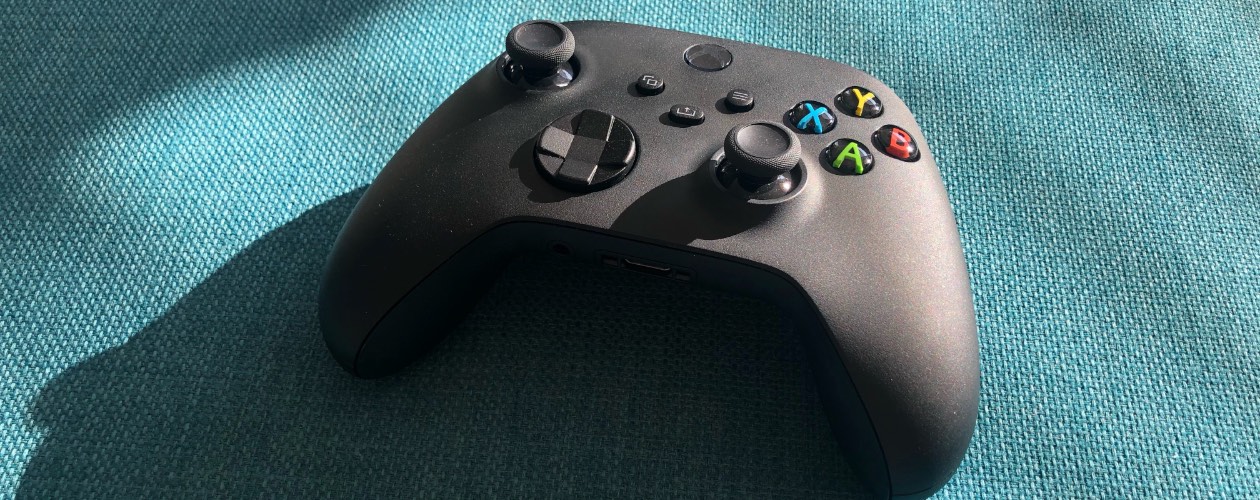At a glance, you’d be forgiven for thinking nothing had changed about the Xbox controller for Xbox Series X|S. It’s got a practically identical silhouette to the Xbox controllers that were shipped alongside the original Xbox One and then updated for the Xbox One S, it also feels instantly familiar as you pick it up, and yet, if you think about what you’re actually holding the subtle differences become clear.
Microsoft’s philosophy for their new controller has been one of refinement instead of revolution. The nips and tucks have been made millimetre by millimetre, ever-so-slightly adjusting the shape of the controller to make it just that bit more comfortable for a slightly broader range of people and hand sizes.

The upper shell has a softer type of plastic, the underside to the hand grips have a rougher texture, and there’s a similarly dimpled texture on the now slightly stouter analogue triggers (still with the individual rumble motors built in to enhance haptic feedback), though they still have the same angle of travel. It feels good in the hand, and to me seems just that little bit more compact, more dense, somehow.
What isn’t subtle, though, is the new D-pad. It adapts the concave design that first debuted on the original Xbox Elite Controller, raising the four primary directions of the D-pad to be more prominent to the touch. It’s sure to be a divisive change, but it does straddle the happy middle ground between having the surety of the four directions of the previous Xbox controller D-pad and better catering to sweeping motions around the disc that will be great for fighting games.
But really, the lack of subtlety comes from just how loud and clackety it is. It’s by far got the sharpest, highest-pitched click of any part of the controller, and brings back bad memories of the first generation Xbox One controller. I’ve no idea why it’s so loud, but it’s been enough to make me start using the analogue stick to navigate in-game menus, to hook up my Xbox One controllers for some peace and quiet.

The rest of the controller’s external features are as unremarkable as it gets. Microsoft have stuck a USB-C port on the controller, though not one on the console itself, and they don’t ship a charge cable with the console either. That’s because they’re sticking with AA batteries or supplementary battery packs to power the controller. Having picked up a decent set of rechargeable batteries, it’s not something I’ve ever had an issue with, and I’m sure many gamers will be happy to carry on using their existing batteries and power packs from the Xbox One era. The battery life is as good as ever.
One of the biggest differences for the new controller is also going to be one of the most intangible. DLI, or Dynamic Latency Input, modifies how the controller transmits your inputs to the Xbox Series X|S. The older gamepads would transmit every 8ms, which in most circumstances is pretty damn fast compared to the 33.3ms of a 30fps game, but could lead to an input slipping to the next frame on Xbox One. In tandem with other improvements through the Xbox Series X|S, not to mention doubling frame rates, it’s allowed The Coalition to halve the input latency in Gears 5, for example, and revisiting Forza Horizon 4 on an original Xbox One feels like you’re trying to steer though marshy bog water.

It’s difficult to shake the feeling that there’s a lack of real innovation here, though. It’s a pure buttons, sticks and triggers controller, with no motion control support and the traditional rumble motors, failing to match what Nintendo and Sony have adopted. Yet it’s easy to forget that Microsoft took their step forward in haptics with the Xbox One, incorporating additional rumble motors into the triggers. It’s a feature that’s often been overlooked by developers over the last seven years, but should see wider adoption now that Sony have incorporated a similar idea with their DualSense gamepad. No, the triggers won’t push back against your fingers, but load up Dirt 5 and get stuck into a race and the four rumble motors assault your fingers and palms with directional feedback as you crash and bash through the offroad racing.






KippDynamite
Even in a vacuum this seems like the most minor improvement possible. This sounds very bland when compared to what news outlets are saying about the DualSense.
And maybe it’s just that I’ve used rechargable controllers for the past 13 years, but it sounds crazy to me that the new Xbox pad still requires batteries!
beeje13
The concerted attack on all parts of the system with regards to latency is one of the strongest points of the Series X|S to me and yet you hardly hear anything about that
Compare that to their storage solution (“Velocity Architecture”) which warrants a brand name, logo, and prominent position on the box, but actually pales in comparison to the competition
Andrewww
Whenever they convince me to get an XBX as a second console, e.g. if Flight Simulator comes out on it in a half-way decent quality, I’d buy myself a third-party controller with symmetrical arrangement of sticks anyway.